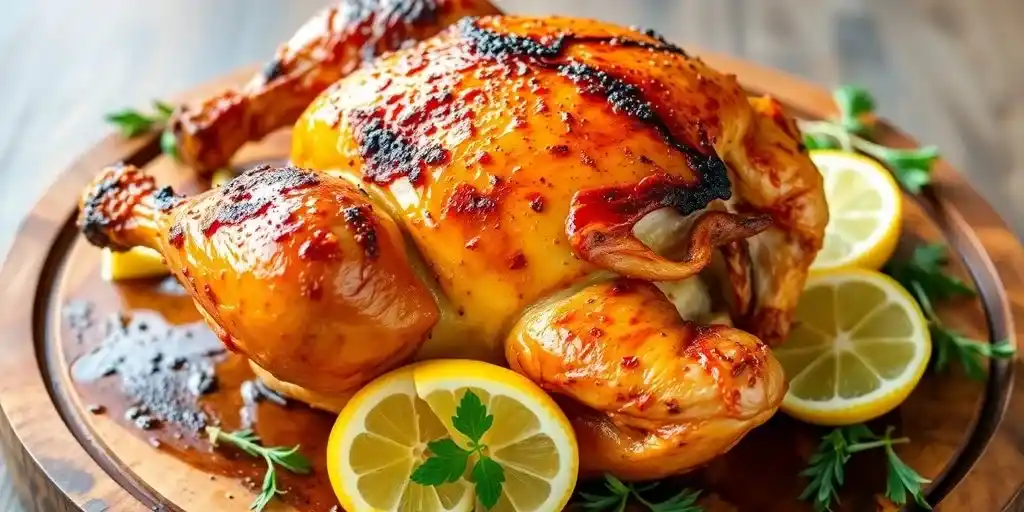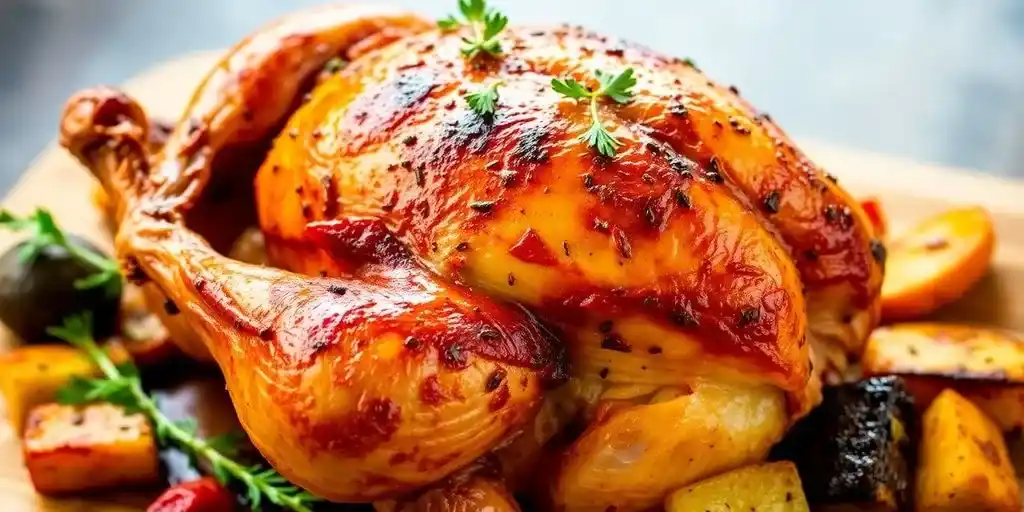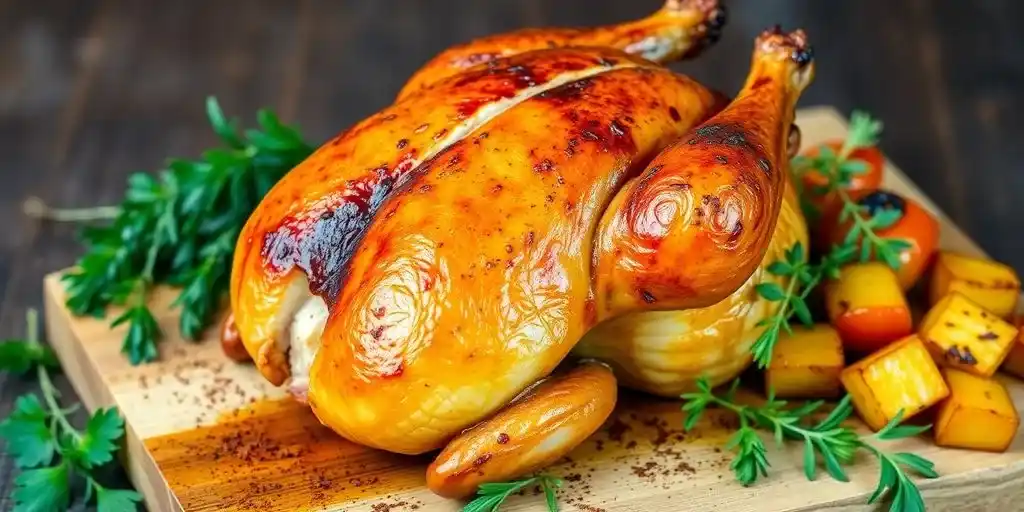Ever tried spatchcock chicken? It’s a game-changer, especially if you’re into quick meals that don’t skimp on flavor. By flattening the bird, you cut down on cooking time and get a roast that’s crispy on the outside and juicy on the inside. This guide will walk you through everything from prep to serving, ensuring you get the most succulent results every time. Let’s dive into the world of spatchcock chicken cooking time and see how high-temp roasting can make your next meal a hit.
Table of contents
Key Takeaways
- Spatchcocking a chicken reduces cooking time significantly by flattening the bird for even heat distribution.
- High-temperature roasting ensures crispy skin while keeping the meat juicy.
- Proper seasoning enhances flavor, so don’t skimp on herbs and spices.
- Monitoring the internal temperature is crucial to prevent overcooking.
- Pairing with the right sides and drinks can elevate your dining experience.
Understanding Spatchcock Chicken Cooking Time
Why Spatchcocking Reduces Cooking Time
Spatchcocking, or butterflying, a chicken involves removing the backbone and flattening the bird. This technique significantly cuts down the cooking time because the chicken can lay flat, allowing heat to circulate more evenly. Instead of spending over an hour in the oven, a spatchcocked chicken can be ready in about 45 minutes to an hour. This method not only speeds up the process but also ensures that every part of the bird cooks at the same rate, reducing the risk of dry meat.
For a deeper understanding of spatchcocking techniques, explore Learn the Essentials of Butterflying and Spatchcocking Chickens.
Ideal Cooking Temperatures for Spatchcock Chicken
For the best results, roast your spatchcocked chicken at a high temperature. Preheat your oven to around 425°F (220°C). This high heat helps to achieve crispy skin while keeping the meat juicy. Generally, it takes about 45 to 55 minutes for a 4-pound bird. Using a meat thermometer, check that the internal temperature reaches 165°F (74°C) in the thickest part of the breast. Once done, let the chicken rest for a few minutes before carving.
Common Mistakes to Avoid
- Skipping the resting period: Letting the chicken rest for at least 10 minutes after cooking allows the juices to redistribute, resulting in a juicier meal.
- Not using a meat thermometer: Guessing the doneness can lead to undercooked or overcooked chicken. Always check the internal temperature.
- Uneven seasoning: Make sure to season both sides of the chicken evenly to enhance the flavor throughout.
Spatchcocking isn’t just a fancy term; it’s a practical approach to roast chicken quickly and evenly. By laying the bird flat, you ensure that every part reaches the perfect temperature without drying out.
Preparing Your Chicken for High-Temperature Roasting
Essential Tools for Spatchcocking
To get started with spatchcocking, you’ll need a few key tools. Kitchen shears are a must-have for cutting through the chicken’s backbone with ease. A sharp knife can also be handy for making precise cuts. Don’t forget a rimmed baking sheet to catch any juices and keep your oven clean. A meat thermometer is crucial to check the internal temperature, ensuring your chicken is perfectly cooked.
For recommendations on tools to simplify spatchcocking, visit The Best Tools for Spatchcocking Chicken.
Step-by-Step Guide to Spatchcocking
- Remove the Backbone: Place the chicken breast-side down on your cutting board. Use kitchen shears to cut along both sides of the backbone and remove it.
- Flatten the Chicken: Flip the bird over and press down firmly on the breastbone to flatten it. You’ll hear a crack as the bone breaks.
- Tidy Up: Trim any excess fat or skin for a cleaner presentation.
Spatchcocking might seem intimidating at first, but once you try it, you’ll find it’s a straightforward way to achieve even cooking and crispy skin.
Seasoning Tips for Maximum Flavor
Seasoning your chicken is where you can get creative. A simple mix of salt, pepper, and garlic powder works wonders. For an extra flavor boost, rub softened butter under the skin. This not only adds richness but also helps in achieving that coveted crispy skin. You can also add herbs like thyme or rosemary for a fragrant touch. Let the seasoned chicken sit for at least 30 minutes before roasting to allow the flavors to penetrate the meat.
Mastering the High-Temperature Roast
Setting the Right Oven Temperature
Roasting a spatchcock chicken at high temperatures is all about getting that perfect balance between crispy skin and juicy meat. Aim for an oven temperature of 425 degrees Fahrenheit. This heat level ensures the skin crisps up nicely while the meat stays tender. A quick tip: make sure your oven is preheated to the right temperature before placing the chicken inside. This helps in achieving an even roast.
How to Achieve Crispy Skin
Crispy skin is the holy grail of roasting chicken. Start by patting the chicken dry with paper towels. Moisture is the enemy of crispiness. Next, season the chicken generously with salt and black pepper. The salt helps draw out moisture, enhancing the crispiness. Finally, place the chicken on a rack in your roasting pan. This allows the heat to circulate all around the chicken, ensuring every bit of skin gets that much-desired crunch.
Discover more secrets to crispy skin in our article Tips for Achieving Crispy Chicken Skin Every Time.
Monitoring Internal Temperature
Keeping an eye on the internal temperature of your chicken is crucial for both safety and flavor. Use a meat thermometer to check the thickest part of the breast and thigh, avoiding the bone. You’re looking for a temperature of 165 degrees Fahrenheit. This ensures the chicken is cooked through but still juicy. If the chicken is browning too fast, cover it loosely with foil to prevent burning while it finishes cooking.
Roasting at high temperatures might seem daunting, but with the right steps, you can master it. The key is to balance the heat to achieve that perfect roast without drying out the meat. Remember, practice makes perfect, so don’t be afraid to experiment with different techniques and flavors.
Serving Suggestions for Spatchcock Chicken

Pairing with Side Dishes
When it comes to pairing your spatchcock chicken with side dishes, think about flavors that complement the savory and juicy meat. A classic choice is a Greek salad, with its refreshing mix of cucumber, tomatoes, and feta cheese, which beautifully balances the chicken’s richness. Consider also serving mashed potatoes or roasted broccoli for a comforting touch. A squeeze of lemon over the chicken and sides can add a bright, zesty note.
Presentation Tips for a Stunning Meal
Presentation is key to making your spatchcock chicken look as impressive as it tastes. Arrange the chicken on a large platter, surrounded by vibrant side dishes. Garnish with fresh herbs like thyme or rosemary for a pop of color. Slicing the chicken before serving can make it easier for guests to help themselves. Remember, the kitchen is your canvas, and a well-presented dish can make your meal feel like a special occasion.
A well-prepared spatchcock chicken doesn’t just fill the stomach—it delights the senses, making every meal a memorable one.
Troubleshooting Common Issues

Dealing with Uneven Cooking
Uneven cooking is a common hiccup with spatchcock chicken. To tackle this, start by using a meat thermometer to check the internal temperature at various spots. Aim for 165°F in the thickest part. If parts are cooking faster, cover them with foil to slow down the process.
For solutions to common challenges, read Common Spatchcock Chicken Mistakes and How to Avoid Them.
Preventing Dry Meat
Dry chicken can ruin your meal. Brining the chicken beforehand is a simple trick to keep it moist. Also, avoid overcooking by monitoring the internal temperature closely. Letting the chicken rest for 10 minutes after roasting helps the juices redistribute.
Adjusting Cooking Time for Different Weights
Chicken size matters. Here’s a quick guide:
| Weight (lbs) | Cooking Time (mins) |
|---|---|
| 3-4 | 45-50 |
| 5-6 | 50-60 |
| 7-8 | 60-70 |
Keep in mind that larger chickens might need a lower cooking temperature. Adjust accordingly to avoid burning the skin.
Remember, cooking is part art, part science. Adjust your methods as needed, and don’t be afraid to experiment. Explore more techniques for perfect spatchcock chicken every time.
Exploring Variations and Techniques
Grilling vs. Roasting: Pros and Cons
Grilling and roasting are both fantastic methods for cooking spatchcock chicken, but each has its unique benefits. Grilling imparts a smoky flavor that’s hard to beat, perfect for summer cookouts. However, it requires constant attention to avoid flare-ups. Roasting, on the other hand, is more hands-off and can be done year-round. The oven’s consistent heat ensures even cooking, making it a reliable choice for achieving juicy meat and crispy skin.
Using Marinades and Rubs
Marinades and rubs can take your spatchcock chicken to the next level. Marinades, which usually contain an acid like lemon juice or vinegar, help tenderize the meat and infuse it with flavor. Rubs, typically a mix of spices and herbs, form a flavorful crust on the chicken’s surface. Try a combination of garlic, paprika, and thyme for a classic taste, or go bold with cumin and coriander for a Middle Eastern twist.
Experimenting with Different Herbs and Spices
Don’t be afraid to play around with different herbs and spices to find what suits your taste buds. Rosemary and sage are traditional favorites, but you can also experiment with less common options like tarragon or fennel seeds. A sprinkle of smoked paprika can add a rich depth of flavor, while a hint of cayenne pepper brings a gentle heat. Freshly ground pepper is always a good choice to add a bit of bite.
When cooking a spatchcock chicken, remember that the technique itself already ensures even cooking and juicy meat. Experimenting with different methods, like flipping, can enhance your results, but isn’t necessary for a delicious meal.
Health Benefits of Spatchcock Chicken

Nutritional Advantages
Spatchcock chicken isn’t just about quick cooking; it’s a nutritional powerhouse too! By removing the bones and flattening the bird, you ensure even cooking, which helps retain more nutrients. This method also allows fat to render more efficiently, leaving you with a leaner meal. Packed with protein, vitamins, and minerals, spatchcock chicken is a great choice for those looking to maintain a healthy diet.
Lower Fat Cooking Methods
One of the most significant benefits of spatchcock chicken is the ability to cook it using lower fat methods. Whether you roast it or grill it, the chicken cooks evenly, reducing the need for added oils. This technique helps you achieve a crispy skin without excess grease, making it a healthier option compared to traditional roasting methods.
Incorporating into a Balanced Diet
Incorporating spatchcock chicken into your meals is a breeze, and it pairs wonderfully with a variety of vegetables. Whether you serve it alongside a medley of roasted veggies or a fresh salad, this dish fits seamlessly into a balanced diet. It’s versatile enough to be the star of a hearty dinner or a light lunch, making it an ideal choice for any meal plan.
The simplicity of spatchcock chicken not only makes it a quick meal option but also a nutritious one, offering a perfect balance of flavors and health benefits.
Wrapping It Up
So there you have it, folks! Spatchcock chicken is a game-changer in the kitchen. By flattening the bird, you cut down on cooking time and end up with a juicy, flavorful meal. Whether you’re roasting it in the oven or grilling it outside, this method ensures even cooking and crispy skin every time. It’s simple, quick, and perfect for any occasion. Give it a try and watch your family and friends rave about your cooking skills. Happy cooking!
Frequently Asked Questions
What exactly is spatchcock chicken?
Spatchcock chicken is a way of preparing the chicken by removing its backbone and flattening it. This helps it cook faster and more evenly.
How long does it take to cook spatchcock chicken?
It usually takes about 45 to 55 minutes to roast a spatchcock chicken in the oven at high temperature, but the time can vary depending on the size of the chicken.
Why does spatchcocking a chicken make it cook faster?
By flattening the chicken, heat can reach all parts of the bird more evenly, reducing cooking time compared to a whole, unflattened chicken.
What tools do I need to spatchcock a chicken?
You’ll need a good pair of kitchen shears to cut out the backbone and a knife to help flatten the bird.
Can I use this method on other birds?
Yes, you can spatchcock other birds like Cornish hens or quails to reduce cooking time and improve evenness.
How can I tell if my spatchcock chicken is cooked properly?
Use a meat thermometer to check the internal temperature. It should be at least 165°F in the thickest part of the chicken.
Crispy Roasted Spatchcock Chicken
- Total Time: 1 hour 5 minutes
- Yield: 4–6 servings 1x
Description
Spatchcock chicken is a game-changer for quick, juicy, and evenly cooked roasted chicken. By flattening the bird, you achieve crispy golden skin and tender meat in less time than traditional roasting. This easy method is perfect for weeknight dinners or special occasions. Serve it with roasted vegetables, potatoes, or a fresh salad for a complete meal!
Ingredients
- 1 whole chicken (about 4–5 lbs)
- 2 tablespoons olive oil
- 1 teaspoon salt
- 1 teaspoon black pepper
- 1 teaspoon garlic powder
- 1 teaspoon onion powder
- 1 teaspoon paprika
- 1 teaspoon dried thyme (or fresh thyme sprigs)
- 1 teaspoon dried rosemary (or fresh rosemary sprigs)
- 1 lemon (sliced, for garnish)
- 4 cloves garlic (smashed, optional)
Instructions
- Preheat Oven: Set your oven to 425°F (220°C). Line a baking sheet with parchment paper or foil.
- Spatchcock the Chicken: Place the chicken breast-side down on a cutting board. Using kitchen shears, cut along both sides of the backbone and remove it. Flip the chicken over and press down on the breastbone until it flattens.
- Season the Chicken: Pat the chicken dry with paper towels. Drizzle with olive oil and rub it evenly over the skin. Season with salt, pepper, garlic powder, onion powder, paprika, thyme, and rosemary on both sides.
- Prepare for Roasting: Place the chicken skin-side up on a wire rack over a baking sheet. Arrange lemon slices and smashed garlic around the chicken.
- Roast the Chicken: Roast in the preheated oven for 45-55 minutes or until the internal temperature reaches 165°F (74°C) in the thickest part of the breast.
- Rest & Serve: Remove from the oven and let the chicken rest for 10 minutes before carving. Serve with roasted veggies, mashed potatoes, or a fresh salad.
Notes
- For extra crispy skin, pat the chicken dry and let it air-dry in the fridge uncovered for 1 hour before roasting.
- Swap olive oil for butter for a richer flavor.
- Add chili powder or smoked paprika for a spicy kick.
- Spatchcocking works well on turkey, Cornish hens, or duck too!
- Prep Time: 15 minutes
- Cook Time: 50 minutes
Nutrition
- Serving Size: 1/4 chicken
- Calories: ~320 kcal
- Sugar: 0g
- Sodium: 500mg
- Fat: 22g
- Saturated Fat: 6g
- Carbohydrates: 2g
- Fiber: 0.5g
- Protein: 30g
- Cholesterol: 110mg
Keywords: How to spatchcock a chicken Crispy roasted spatchcock chicken Spatchcock chicken cooking time Easy spatchcock chicken recipe High-temp roasted chicken
